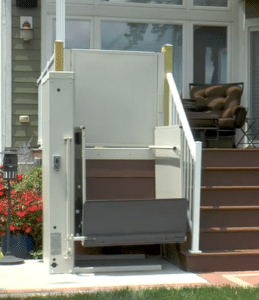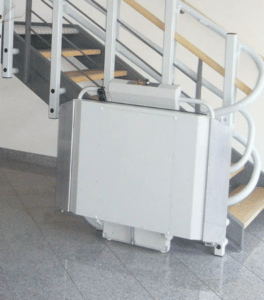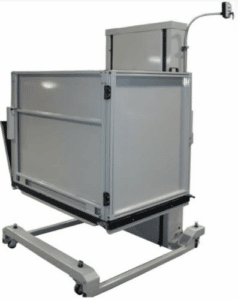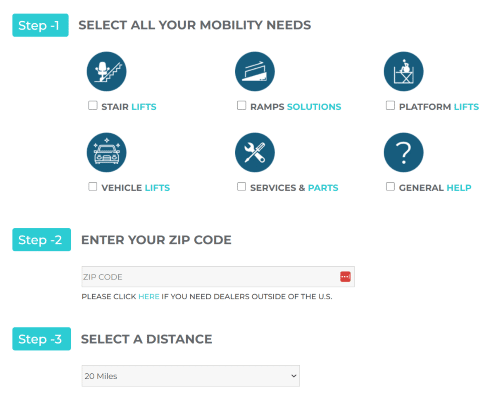With more than 2,200 five-star reviews on Trustpilot, Bruno is our pick for “Most Customizable” due to its positive reputation among both dealers and customers. Bruno has also won multiple awards for innovation, manufacturing quality, and product success. After checking further into Bruno, the Reviews Team agreed that it offers one of the best lines of wheelchair lifts on the market.
The Best Wheelchair Lifts of 2025: Elevate Your Mobility
Key Takeaways
- Wheelchair lifts are motorized platforms that carry people in wheelchairs over barriers such as stairs. Whether they’re used temporarily or permanently, wheelchair lifts grant independence in the home without the need to transfer out of the wheelchair.
- Wheelchair lifts are expensive, but many dealers provide financing options or a selection of pre-owned or rental lifts. Local and government programs may help cover the cost.
- The most important considerations when buying a wheelchair lift for stairs are safety, accessibility, price, and maintenance. Make sure to identify your accessibility needs as you search for a wheelchair lift in your price range.
- The best wheelchair lifts of 2025 include Lifeway Mobility, Bruno, Savaria, AmeriGlide, and Harmar.
As the American population ages, more people report decreased mobility. At least 18% of Americans who report altered mobility are age 70 or older, according to the Bureau of Transportation Statistics. And many use at least one assistive device to aid in mobility, like canes, walkers, and wheelchairs. [1] Bureau of Transportation Statistics. Travel Patterns of American Adults with Disabilities. Jan. 3, 2022. Found on the internet at https://www.bts.gov/travel-patterns-with-disabilities
But mobility changes don’t mean losing your freedom to move around your home and community. Many people choose to use a cane or wheelchair to improve their confidence, safety, and independence while moving about. If you use a wheelchair, then you may also benefit from a wheelchair lift for your home. Wheelchair lifts are a type of stair lift that function as a substitute for stairs where a ramp isn’t suitable, both inside and outside your home.
Wheelchair lifts have two main categories: vertical and inclined. Vertical platform lifts act like elevators to transport you to other floors, and inclined platform lifts travel along your staircase diagonally on a wall-mounted track to transport you to the next landing. Some home wheelchair lifts are powered by your home’s electricity, while others are powered by a rechargeable battery. All lifts are high-priced, but there are options to reduce the cost.
As you consider your options, consider our Reviews Team’s top picks for the best wheelchair lifts in 2025.
A quick look at the best wheelchair lifts of 2025
- Lifeway Mobility: Best Dealer
- Local Expert Installation of Bruno and Harmar Lifts
- Bruno Wheelchair Lifts: Most Customizable
- Savaria: Most Home Lift Options
- AmeriGlide: Best Portable Lift
- Harmar: Best Outdoor Lift
Why you can trust our expert review
Our Reviews Team recommends products and services we believe provide value in the lives of our readers. We’ve spent more than 100 hours carrying out in-depth research on home wheelchair lifts to give you the most accurate review. To make our selections, we:
- Engaged in ongoing independent research
- Consulted with physical and occupational therapists
- Mystery shopped 10 brands and seven dealers
- Read verified customer reviews from trusted third parties such as the Better Business Bureau (BBB) and Trustpilot
The best wheelchair lifts
| Starting price | $7,000 – $25,000 | $7,000 – $25,000 | $10,000 – $25,000 | $3,999 – $13,495 | $6,300 – $7,500 |
| Type | Vertical and incline platform lifts | Vertical platform lifts | Vertical and inclined platform lifts | Vertical platform lifts | Vertical platform lifts |
| Power source | Household current or rechargeable battery | Household current or rechargeable battery | Household current or rechargeable battery | Rechargeable battery | Household current |
| Financing | Available | Refer to dealer | Refer to dealer | Available | Refer to dealer |
| Maximum weight capacity (lbs) | 750 | 750 | 1050 | 1000 | 750 |
Best wheelchair lifts of 2025
What are home wheelchair lifts?
Home wheelchair lifts are a great mobility solution for those who need to access different floors or levels. Wheelchair lifts come in two main categories: vertical platform lifts and inclined platform lifts.
Types of wheelchair lifts
Vertical platform lifts
Vertical platform lifts are similar to elevators. They use a platform to help you go up or down to other floors in your home, but they don’t usually come in an enclosed shaft like an elevator. Instead, they travel in an open-air tower that serves as the travel path. The platform itself is surrounded by a half-wall barrier for safety.
Vertical platform lifts are great accessibility solutions for home entrances with stairs to the porch or patio, and for multi-level homes. Some lifts travel a few feet, while others can travel up to three floors. You can also find vertical wheelchair lifts that grant access to vans without leaving the wheelchair. Companies like BraunAbility convert vans to hold vertical lifts so that wheelchair users can be accommodated without having to transfer seats. Just like home vertical platform lifts, you can stay in your wheelchair as you’re moved safely into the car.
Vertical platform lifts take up space. The platform’s floor space needs to be at least 36 inches wide by 48–60 inches long, depending on your home’s door placement and the space at each landing. There also needs to be at least 80 inches of headroom clearance to accommodate everyone, including larger power wheelchairs that sit higher off the ground and any standing passengers that are accompanying the wheelchair user. Lifts are also very heavy, since they must carry up to 750 pounds to meet ADA standards, which ensure accessibility to all intended users. [3] Internal Revenue Service. About Publication 502, Medical and Dental Expenses. Found on the internat at https://www.irs.gov/forms-pubs/about-publication-502

The platform must be at least 48 inches by 36 inches if the doors are on the narrow ends. If the doors are on a narrow and wide end, then the wide end must be 60 inches.
Most companies or dealers can install a lift without needing to make any major home renovations, but that largely depends on the home’s layout. If the lift would require an adjustment to your ceiling and upper level floor to allow access to multiple levels, an inclined platform lift or home elevator could be more cost-effective for you.
Inclined platform lifts
Inclined platform lifts are very different from vertical platform lifts, but they accomplish the same thing by transporting a person in a wheelchair to a different floor. These lifts are accessibility solutions that travel along staircases, using a platform and locking bars to safely accommodate people in manual wheelchairs. The platform rides on a track that’s mounted on the wall and, depending on manufacturer and model, can travel along straight or curved stairways. Inclined platform lifts are not designed to carry loads of more than 550 pounds and so are not recommended for power wheelchairs, which are much heavier than manual wheelchairs
Inclined platform lifts require a larger footprint than a vertical platform lift. The platform itself must meet the same requirements for safety, but because of the track length along the staircase, the occupied space is more noticeable.
These lifts can usually be installed without major renovations, but some require wall mounts, which can damage the walls when they’re removed. If you’re renting your home, you’ll have to talk to your landlord first, before ordering a lift—not so they can give you permission, but to facilitate collaboration with the installer, ensuring the lift meets safety and accessibility requirements. According to the Reasonable Modifications Rule under the Fair Housing Act, your landlord must permit accessibility modifications in your home so long as your modifications do not cause undue administrative or financial burden on the landlord, which is determined on a case-by-case basis. [4] Medicare. Patient Lifts. Found on the internet at https://www.medicare.gov/coverage/patient-lifts Find more information about Reasonable Accommodations and Modifications on the United States Department of Housing and Urban Development website.
Standard features in wheelchair lifts
All wheelchair lifts come with certain features that must comply with the American Society of Mechanical Engineers (ASME) A18.1 and A17.1 Safety Standards. These standards are the guidelines of all wheelchair lift manufacturers to make sure they are safe for all intended users. This includes requirements for structural support, access ramps, minimum dimensions, and weight capacity. If you want to ensure your lift is safety-code compliant, look for the ASME certification on the brand website, or talk to a professional who can verify it for you.
Note that meeting ASME Safety Standards is not the same as being ADA compliant. While the ASME A17.1 and A18.1 certifications ensure that the lift is safe for use, ADA compliance ensures that the lift grants accessibility and unassisted operability to everyone in public and business environments. Home wheelchair lifts don’t have to follow ADA compliance since it is a community standard, but they should follow ASME Safety Standards.
You should expect to see the following standard features in all wheelchair lifts:
- Button or joystick controls on the side of the platform (ASME A18.1 requirement)
- Barriers that protect you from falling off the lift as it travels (ASME A18.1 requirement)
- Emergency stop and alarm buttons
- Wall-mounted or wireless call stations to call the lift if it’s on the opposite landing
- Obstacle sensors at the bottom or leading edges of the lift to detect incoming obstacles and stop the lift
Every wheelchair lift needs a power source. Some lifts are plugged into an outlet and function on household current. Other lifts run on a rechargeable battery, with the power station that keeps the battery charger plugged into a household current. The advantage of rechargeable batteries is they can continue to power the lift in the event of a power failure for at least a few trips so you’re not left stranded on the platform or on one level of your home.
How much do wheelchair lifts cost?
Wheelchair lifts vary in cost, but starting prices generally range from $2,000–$30,000, depending on your needs. You can find different prices for the same lift, depending on the dealer. And there are many customization options and home environment considerations—like platform sizes or weather-resistant coating—that could cause the price to fluctuate.
The biggest variables are lift type and travel distance, but customizations can come with a hefty price tag, too. Let’s see what that looks like for each type.
Cost of vertical platform lifts
Vertical platform lifts vary from a starting price range of $4,000–$30,000. Lifts that need to travel only 4–6 feet, such as the distance from the ground to a home entry or porch, stay lower in this price range than lifts that need to travel to second floors. Usually, installation is included in the cost, but that depends on the dealer.
Cost of inclined platform lifts
Inclined platform lifts vary from a starting price range of $2,000–$15,000. Wheelchair lifts for straight staircases tend to cost less. Lifts that need to travel across landings or curves will cost more because the track must be custom-made to fit your staircase.
Cost of wheelchair lift customizations
Most brands offer optional features and customizations to meet your needs. Each added feature can increase the price of the lift, but this depends on how much the original lift needs to be modified and the cost of additional parts.
Small modifications, like enlarging control buttons or swapping buttons for joysticks, could add a few hundred dollars to account for the different parts. Major modifications, like switching the power source from household current to a rechargeable battery, or increasing weight capacity, could add a few thousand dollars because it alters how the product is manufactured. Adding a third floor to a vertical lift or adding turns to an inclined lift can spike the cost closer to the $15,000–$30,000 price range because of the added materials, manufacturing time, and installation effort.
You may save some money by implementing some superficial wheelchair lift modifications yourself. Brittany Ferri, an occupational therapist in Rochester, New York, told our Reviews Team that some modifications can be added after purchase to make a lift easier to use. For example, “Sometimes we can add tactile bumps on different controls to make it easier to feel where switches are located,” said Ferri. If you plan to add modifications to your lift, make sure they do not damage the lift’s parts, as repair may not be covered due to what the manufacturer would consider device tampering.
Pros/cons of wheelchair lifts
Pros
- Offers a safe solution for accessing different floors in the home
- Available as vertical platform lifts or inclined platform lifts to accommodate your home set up
- Most manufacturers and dealers offer financing options
- Select dealers offer used or rental wheelchair lifts as affordable options
- When professionally installed, lifts are safe and reliable
- Many brands offer lift modifications to meet individual needs
Cons
- Costs thousands of dollars
- Finding insurance coverage or public programs to help offset the cost is difficult
- Turnaround time from purchase to installation could take weeks, particularly custom-made lifts
- Takes up a lot of space in the home
- Industrial designs not always pleasing to look at
- Few brands offer decor options to better suit customers’ homes
How to buy a home wheelchair lift
Buying either a vertical or inclined platform lift typically requires two steps:
- Measuring for a wheelchair lift, which requires a professional from the manufacturer or dealer to survey your home, take you through your options, and give you an accurate price. This step can also be used to determine if your home needs any modification prior to installation. If so, these modifications could be done while waiting for the lift to arrive for installation.
- Manufacturing and installing the wheelchair lift, which occurs a few weeks (or days, in some cases) after purchasing your lift from the manufacturer or dealer.
Step one: measuring for a wheelchair lift
You should always measure your home to ensure your wheelchair lift will fit. Most manufacturers and dealers advise getting a professional survey of your home to ensure the lift is appropriate.
- For vertical platform lifts, the surveyor will measure your home to ensure your desired platform size can fit. The surveyor also ensures there is adequate space for entrance and exit pathways on each landing for your wheelchair. If your lift will be installed outside, the surveyor may require you to install a concrete pad at the bottom landing to safely accommodate the lift on a stable surface. Second-story landings will need to have an opening to safely enter or exit the lift, so the surveyor may also recommend removing access barriers and replacing them with hinged gates.
- For inclined platform lifts, the surveyor will take several measurements of your staircase, including the length with and without landings, step height, and staircase width to make sure the platform you need will fit. If your staircase is curved, the surveyor accounts for this in the measurements. Similar to vertical platform lifts, the surveyor will ensure there is enough space for your wheelchair to enter and exit the platform at each landing.
In both instances, an electrical outlet must be nearby. If there is no outlet to power the lift or recharge station (if you opt for a rechargeable battery source), you’ll need to hire an electrician to install at least one outlet.
Surveyors may also ask about your specific accessibility requirements to determine which customizations can best accommodate you. For example, many vertical platform lifts have grab bar add-ons for added safety during travel. If you have a heavy power chair and need caregiver assistance, the AmeriGlide vertical platform lift can increase weight capacity to 1,000 pounds to accommodate you, your chair, and your caregiver in one ride.
Once you agree on the model, features, and price, you’ll move forward to the manufacturing and installation process.
Step two: manufacturing and installing the wheelchair lift
After your order is placed, it could take at least two to three weeks for your order to be manufactured and shipped to you, depending on whether customizations are added to the lift. This is especially true for inclined platform lifts that ride curved staircases, because the track needs to be custom made to fit the shape of your staircase.
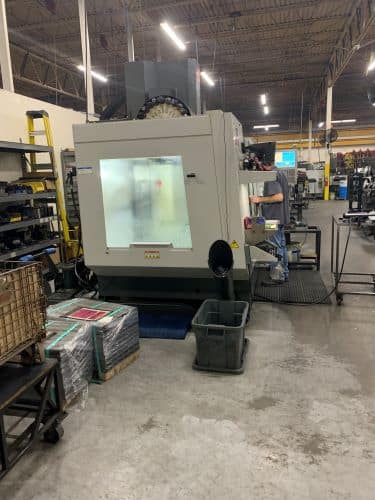
Both vertical and inclined platform lifts take at least 4–6 hours to install. Some lifts, like the AmeriGlide vertical platform lifts, can arrive fully assembled, which reduces installation time but increases shipping cost. If there are additional home modifications needed to accommodate the lift, the installation time will extend by a few days.
Most manufacturers and dealers advise hiring a permitted professional to do the installation. Check your state and local ordinances, since many states (Alabama, Arkansas, California, Colorado, Connecticut, Washington, D.C., Georgia, Hawaii, Kentucky, Massachusetts, Michigan, Minnesota, Montana, Nevada, Oklahoma, Oregon, Virginia, Washington, West Virginia, Wisconsin) will fine you for installing lifts unpermitted due to safety concerns.
Most manufacturers roll the installation fee into the quoted price. AmeriGlide are the only brands in this review that do not automatically do so because neither company offers installation. Instead, you’ll need to call a third-party lift installation service to help you install the lift properly. This can potentially cost an extra several thousand dollars.
Installing a vertical platform lift is a simple process compared to inclined platform lifts because the product is limited to one large unit placed in one area of the home. It’s typically fully or partially assembled on arrival. Installation can get more complicated if the lift travels to multiple levels in the home, requires an enclosed shaft, or if home modifications are needed to accommodate the lift, like removing boundaries to the top landing for entry and exit space.
Installing an inclined platform lift is more involved, especially if the staircase is curved. The installing technician will place the track first, mounting it securely to the wall for the entire length of the staircase. Then, the platform is securely attached to the track and ready to test run. On curved stairlifts, installation takes longer to ensure it fits each turn perfectly to allow for a smooth ride.
Wheelchair lift maintenance and warranties
Wheelchair lifts require maintenance once every year through the manufacturer or dealer that sold you the lift. Sometimes, this is covered in the lift’s warranty, but not always.
Maintenance
Most wheelchair lifts last 10–20 years with proper care. Day-to-day maintenance includes dusting gently around electrical equipment with a dry cloth. Avoid harsh chemicals and abrasive cleaners, especially around buttons and circuitry.
If your lift is outdoors, cleaning the surface of the lift frequently can help keep grime out of the nooks and crannies that lead to internal mechanical equipment like gears. Clearing snow and ice from the lift will help prevent corrosion so your lift stays safe and accessible.
You’ll need to hire professional maintenance every year or every 750 up-down cycles, whichever comes first. Most dealers will have a list of local professionals you can contact. Some states, like Oregon, have strict maintenance policies and checklists designed to keep the lift safe and operable. This includes lubricating gears, checking latches and hinges for faults, and ensuring the lift’s circuitry is damage-free.
Should your lift malfunction, call the dealer or technician who installed the lift. Every company on this list sells their lifts through a network of licensed dealers. Your dealer’s technician will come to your home and assess the issue. If the malfunction requires replacement parts, they will call your lift’s brand and order parts. If your lift was installed through a local dealer, your technician may have a part on hand. Repairs depend on technician availability, so find out if your area has enough technicians to service your home in a timely manner. Remember that your lift is important for your home accessibility, and you don’t want to wait longer than one to two days for a repair.
Warranty
Wheelchair lift warranty lengths vary, depending on the manufacturer and dealer. They typically cover at least a year for major components like gears and motors, with lesser coverage times for smaller parts like buttons and barriers. Warranties tend to cover the cost of replacement parts, repairs, and labor—but not all companies have the same coverage. To fully understand your warranty, ask about coverage length and terms for these specific parts and services:
- Professional servicing
- Track or tower, depending on your type of platform lift
- Major repairs on parts like motors, gears, and circuitry
- Minor repairs on parts like buttons, barriers, and gates
- Replacement parts and labor
All warranties cover manufacturing and installation defects, but they do not cover wear-and-tear or damage inflicted by an external source. For example, if your dog chews your power cord, you’ll need to pay for a replacement out of pocket.
How to save money on wheelchair lifts
Wheelchair lifts are expensive, but they can play a huge role in your ability to access your home and community. What are some cost-saving strategies to help lower the financial barrier?
Ask insurance for coverage
Insurance rarely covers wheelchair lifts. Part B Medicare’s policy states that it may cover patient lifts as prescribed durable medical equipment (DME), but this refers to Hoyer lifts or ceiling lifts that help caregivers transfer patients from beds and chairs. Wheelchair lifts don’t usually make the cut.
But if the wheelchair lift is deemed medically necessary, Medicare may cover it, as long as a doctor writes a prescription with medical justification for the device.
Medicaid may offer coverage, although this differs state-to-state. Most Medicaid programs will offer assistance for stair or wheelchair lifts through Medicaid Home and Community Based Services (HCBS) waivers, which help cover at least part of your expense. Call your local Medicaid office to see how you can qualify for a waiver or any other programs available in your state.
If you have private insurance, call and ask about what’s covered under your policy. It may provide at least partial coverage, or the insurance company can direct you toward local or government programs for assistance. You can also check online tools like NCOA’s BenefitsCheckUp to see what benefits are available in your area by entering your ZIP code and selecting the assistance you need. Local programs like Habitat for Humanity, Rebuilding Together, and Veterans service organizations are also excellent resources for advice on wheelchair lift cost, coverage, and installation.
Get a tax deduction
Wheelchair lifts and maintenance costs can be tax deductible. You’ll need to prove it was a medically necessary purchase by keeping your doctor’s prescription for the lift on hand. Keep the receipt for tax season and list your expense as an “itemized deduction” for medical purposes. You can find more information on the IRS website.
Purchase a used wheelchair lift or rent instead
Many manufacturers and dealers have used wheelchair lifts at their warehouses. Some dealers, like 101 Mobility, have select locations that buy back and refurbish pre-owned wheelchair lifts to sell in their used inventory. But the company warned our Reviews Team that used lifts have waiting lists because of their popularity. Some lifts are difficult to purchase used, like curved inclined platform lifts. Curved staircases require custom-built tracks. If you have a uniquely curved staircase, you may have to invest in a new lift customized for your specific staircase. Keep in mind that warranties are different for used lifts than new ones, so ask a professional for those details before you purchase.
You can also try searching on Ebay and Amazon, although wheelchair lifts are hard to find on these sites. The Reviews Team found two vertical platform lifts available on Ebay for as low as $1,500, and one vertical platform lift on Amazon with hidden pricing. There were no inclined platform lifts listed on either site. Any lift you find on Amazon or Ebay will not come with a warranty because secondhand wheelchair lifts are a liability.
If you’re looking for a wheelchair lift to serve as a temporary mobility solution, you may want to consider renting instead of buying. After discussing this option with dealers like Lifeway Mobility, buying and reselling may be a better option than renting because of the custom nature of most lifts to people’s homes.
Finance the wheelchair lift
Some manufacturers or dealers offer financing options to lower the initial cost. You can check with the wheelchair lift’s retailer to see how you can apply. If you do qualify, you’ll pay an upfront fee followed by monthly payments until the wheelchair lift is fully paid off.
Who are wheelchair lifts best suited for?
Wheelchair lifts can provide increased freedom in your home and community. More than 8% of Americans report mobility-related travel restrictions that limit their ability to leave home and interact with their community. Of these people, 11.2 million are age 65 and older, and 15.5% of those with mobility-related travel restrictions use manual or power wheelchairs. As a result, they tend to restrict their day-to-day travel, which can leave them increasingly homebound over time. [1] Bureau of Transportation Statistics. Travel Patterns of American Adults with Disabilities. Jan. 3, 2022. Found on the internet at https://www.bts.gov/travel-patterns-with-disabilities Research shows that staying homebound can cause or increase feelings of isolation, depression, and anxiety. [5] National Library of Medicine. Correlates of Depressive Symptoms among Homebound and Semi-Homebound Older Adults. April 2017. Found on the internet at https://www.ncbi.nlm.nih.gov/pmc/articles/PMC5845464/
Anyone who uses a wheelchair full-time should consider getting a ramp or lift to replace staircases and support social and emotional health. If a ramp isn’t the most accessible option, experts recommend exploring a lift.
“In some cases, wheelchair ramps are not the most accessible options,” Ferri told us “There are instances where a ramp can block other people from using an entryway, prevent cars from being stored in the garage, and otherwise get in the way of those living in the home. In cases such as these, it’s possible wheelchair lifts are a better fit.”
Ferri also explained that wheelchair lifts are not for everyone. “People should have good safety awareness, judgment, and motor planning” when using a lift,” said Ferri “The same goes for memory—if they got training on the sequence and what to do in an emergency, they should be able to recall that on their own each time they use [the lift].” If you or a family member are noticing cognitive changes, you may want to consider a safer option.
If you’re unsure whether you’re able to independently and safely operate a wheelchair lift, call a dealer and make an appointment to visit their showroom with a family member to see if you can test run a lift with their guidance and on your own.
What to look for in the best wheelchair lifts
When you’re looking to buy a wheelchair lift, your first considerations should be safety and accessibility. No matter the price, if the lift cannot safely meet your needs, the investment isn’t worth it. Look closely at the safety features and modification options to make sure the brand and model can meet your needs. Ask yourself the following questions:
- Does the wheelchair lift safely accommodate the weight and size of my wheelchair and myself?
- If my caregiver is going to ride with me, does the lift accommodate the total weight? Do I need an enclosure to make sure we stay safe?
- Does it come with call stations so I can call the lift if it’s on the opposite landing?
- Does the lift have rechargeable batteries in case the power goes out so I’m not left stranded?
- Does the lift have obstruction sensors that detect an obstacle and stop the lift before hitting it?
- Does the lift have modifications that meet my needs, like larger platforms to fit my wheelchair or alternative controls that are easier for me to operate?
- Do I feel safe reaching to open the lift’s doors, or should I invest in a power-operated door that opens at the push of a button?
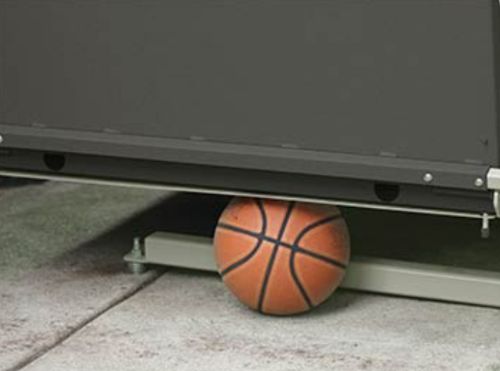
If you’re unsure about your accessibility needs, ask your doctor for a referral to an occupational or physical therapist. They can point out details you may not have considered, like which control configurations are best or how to get in and out of a lift safely. You may also be referred to a social worker or case manager who can set you up with a home safety specialist, a professional who closely analyzes homes and recommends safety modifications.
Once you know what you need, look at the price tags. Compare lift types and brands to find something in your budget range. Talk with different dealers and ask them to show you all of your options and whether they provide financing opportunities. If you had a home safety specialist assess your home, keep their phone number on hand so that you can call them and ask for advice if you run into any roadblocks.
How we chose our top picks
Based on our expert consultations and research, we determined the following factors to be important for our readers when shopping for a wheelchair lift:
- Price: We considered the price range of each wheelchair lift from both manufacturers and dealers.
- Financing options: We searched each brand to see who offers financing options to improve affordability.
- Warranty: We looked into each brand’s warranty length and terms for your consideration before you buy.
- Adaptability to the home and user: We examined each brand and model for a variety of functional features that would accommodate your unique needs.
- Customer satisfaction: We studied customer reviews on sites like BBB and Trustpilot to see what customers like and dislike about each brand.
- Customer service, including installation: We experienced customer service ourselves by calling each brand and asking questions about pricing, purchase and installation processes, and lift specifications.
- Customization: We considered preferential features like color modifications and enclosure styles so that you can find a lift that meets your “wants” list.
- Safety features: We compared safety features for each lift so you can determine the safest option for you.
- Product reliability: We determined each lift’s dependability by assessing factors like its power source so you can choose a lift that doesn’t leave you stranded between floors.
We had all of our selections medically reviewed by an expert in the field to ensure each brand and model is appropriate for our readers’ needs.
Bottom line
Wheelchair lifts serve as a great alternative to stair negotiation for those who use a wheelchair full-time. Although they’re expensive, there are affordable options, like financing or buying used.
The market is full of great wheelchair lift brands, but these picks have cleared our reviews process as the best and safest quality. Consider each one carefully, as they all have unique features that may fit your needs best.
If you’re not sure what’s best for you, consult with a dealer to get a home evaluation, or ask your doctor for a prescribed clinical assessment. Physical and occupational therapists are also qualified to assess your individual needs and recommend features that can be useful. Some are even qualified to assess your home environment for appropriate home modifications that can lower your falls risk.
Frequently asked questions
In most cases, no. Medicare rarely covers wheelchair lifts for vehicles, even if you have a prescription from a doctor. Some Medicare Advantage plans may consider coverage, but approval is rare.
Medicare does not usually cover wheelchair lifts. Some Medicare Advantage plans might, but it is still difficult to get any type of insurance to cover wheelchair lifts.
Wheelchair lifts range greatly in cost. Depending on the type of wheelchair lift and necessary modifications to fit your needs, you’ll pay between $2,000–$30,000 starting price.
Wheelchair lifts for vans can be quite costly. Lifts that allow you to remain in your wheelchair to enter the van can cost $20,000–$30,000 without modifications. These lifts require complete van remodeling, which is why the starting price is so high. You also have the option to buy a new or used converted van with the lift already installed.
Wheelchair lifts have a control panel that allows for independent operation. While you’re on the lift, you can control the switches to select which direction you want to travel. With some lifts, you can add controls to automate gate opening, too. If the wheelchair lift is on the opposite landing, you can use a remote or wall-mounted calling system that “calls” the lift to you.
Professional installation is highly recommended to ensure safety. An improperly installed lift can be dangerous. Ask the lift’s manufacturer or dealer whether professional installation is bundled into your price. If not, hire a professional to do the work. Third-party installation can cost between $500–$5,000, depending on the lift and the amount of effort required, but it’s worth the peace of mind.
Some dealers and manufacturers have rental programs for temporary use. Dealers don’t encourage this, though, due to the custom nature of most wheelchair lifts.
Wheelchair lifts work by using a platform to transport you to a different level. Vertical platform lifts allow you to travel up or down to different floors, similar to an elevator. On inclined platform lifts, the platform travels diagonally on a wall-mounted track along a staircase. All lifts are independently operable, which means you can guide the lift yourself.
Most vertical platform lifts are allowed a lift height of up to 14 feet, but the maximum height depends on your state’s law. Some lift companies claim their lifts can travel up to three stories.
Most inclined platform lifts have a maximum track length of 16–40 feet, depending on the brand and model.
Commercial wheelchair lifts can be more costly than home lifts. Prices start around $15,000 and can go as high as $75,000, especially if building modifications are necessary.
Weight capacity depends on the type of lift. Standard vertical platform lifts carry up to 750 pounds with options for heavier weights, while inclined platform lifts carry up to 550 pounds.
For help from a professional, you might turn to an occupational therapist. An occupational therapist can provide a home assessment and make recommendations for home modifications that allow aging in place. These changes could involve modification to the main level of a home for optimal function, inexpensive options for bed placement, and bathroom modifications, such as elevated seats, improvised lighting and grab bars. To find an occupational therapist with expertise in home modifications, visit the Home Modification Occupational Therapy Alliance (HMOTA). The HMOTA is a worldwide network of occupational therapists that specialize in home modifications. An occupational therapist can also help you decide if a wheelchair lift is right for you, and if so, what lift product best meets your needs.
Have questions about this review? Email us at reviewsteam@ncoa.org.
Sources
- Bureau of Transportation Statistics. Travel Patterns of American Adults with Disabilities. Jan. 3, 2022. Found on the internet at https://www.bts.gov/travel-patterns-with-disabilities
- ADA.gov. ADA Standards for Accessible Design Title III Regulation 28 CFR Part 36 (1991). March 14, 2014. Found on the internet at https://www.ada.gov/law-and-regs/design-standards/1991-design-standards/
- Internal Revenue Service. About Publication 502, Medical and Dental Expenses. Found on the internat at https://www.irs.gov/forms-pubs/about-publication-502
- Medicare. Patient Lifts. Found on the internet at https://www.medicare.gov/coverage/patient-lifts
- National Library of Medicine. Correlates of Depressive Symptoms among Homebound and Semi-Homebound Older Adults. April 2017. Found on the internet at https://www.ncbi.nlm.nih.gov/pmc/articles/PMC5845464/
- United States Access Board. ADA Accessibility Standards. Found on the internet at https://www.access-board.gov/ada/#ada-410







